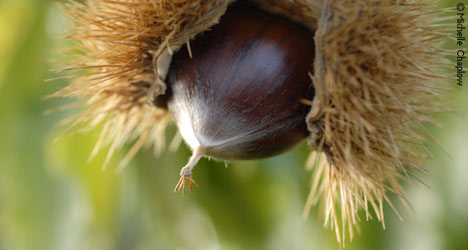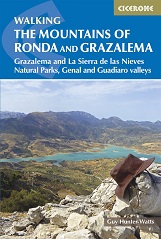
Cartajima
Located halfway between the Ronda-San Pedro road and village of Juzcar, Cartajima is a small, quiet hamlet. It is one of the highest communities in the province of Malaga, at 846m above sea level. Like other villages in the Alto Genal of the Serrania de Ronda, Cartajima is famous for its chestnut trees , which are harvested in October and November. In the 19th century cannon factories brought wealth, and the town was known as “Little Cadiz”.
Cartajima has a spectacular setting: a backdrop of mountainous limestone dominates the village from behind. The contrast between the white limestone massif (the Sierra de Oreganal) above the village, and the low-lying chestnut, oak and cork-oak woods below, is sharp and dramatic.
HISTORY
Records of the community’s long history were lost when the archives and church were torched during the early days of the Civil War in 1936. The village has Roman origins (some coins were found when Las Penuelas was built), as well as tombs from the Phoenician period at Cortijo del Raton. A further Roman site at Cañada de Harife may have had some baths, fed by natural hot springs, possibly located at Pilar de la Higuera. More>
The village can be reached by its own very small side-road from the San Pedro to Ronda road. Just before the junction it is worth stopping and contemplating the landscape: the modern lane does not follow the old medieval track, and below the road by Pilar de la Higuera, the old mule track can be seen. This spot is the site of a spring where livestock were watered when going to market. A Roman hot water spring is also supposed to be located in this area. The water flows out of the limestone mass and is channelled into 18th-century water channels and pools.
SEE & DO
Nuestra Señora del Rosario
Our Lady of the Rosary occupies the highest point in the village and still dominates the village. The16th-century building is very simple with a rectangular nave and a tower to the right. A flight of stairs leads up to a Baroque doorway. The interior was restored in 1941 after it was burned during the Civil War. The ceiling is of plain unpainted wood, with perforated tie beams in the artesanado tradition. A large painting by Miguel Martín, the celebrated Ronda painter-photographer, dedicated to the village in honour of his birth in the pueblo in 1947, adorns the wall. Two statues from the 17th and 18th century, one dedicated to Jesus and the other to Our Lady of the Rosary, are set in a central niche.
Fountain of the Fishes
This spring located in Camino de Arroyo Blanco on the outskirts of the village is of Moorish origin. On the left is the trough for animals to drink, which has a lower front wall than the main spring. You can see the tiny air bubbles clinging to the trough base where the water filtered percolating upwards. On the right is a a small closed cistern with modern glass window, inside you can see the elements typical of Arab architecture such a domed ceiling. Other decorative reconstruction such as battlements turrets on top of the back wall of the spring may or may not be historically correct.
The village itself has steep, narrow streets, offering spectacular views over the surrounding chestnut, oak and cork-oak forests.
Outside the village
Los Riscos
Heading south towards Juzcar, El Risco karstic formations are situated on the boundary with Juzcar in the limestone landscape. Part of the Sierra del Oreganal the limestone outcrops has been carved by the elements – wind and rain - into extraordinary natural sculptures, whilst not as impressive as El Torcal, they are still worth a visit. One rock formation is called El Aguilar de los Riscos (the eagle of los Riscos) as it looks like a bird of prey watching over the horizon. This limestone mountain is also the home to Cueva de Diego and Carrión. Many a treasure hunter in the search of hidden Moorish booty has probably visited both caves. On maps they are situated to the east of the village, well inside the limestone mountain. There is a visitors or interpretation centre located at the entrance to the village with four rooms of display that explain Los Riscos in detail. This would be a good starting point if you want to walk up to Los Riscos. Video of Los Riscos Visitors Centre.
To visit Los Riscos, drive towards Júzcar on the MA-7303. 100m past km3 there is a turning on the right hand side signposted (only for approaching from the other direction) which you follow (turning back on yourself) up a narrow but good condition farm track. It has been upgraded with many concrete pavement section and is passable with care by car. After three km you reach a car par park at a point known as the Mirador del Nacimiento las Zúas. Here Los Riscos tower above. The circular 3km walk known as Sendera de las Eras around Los Riscos begins here, the path leads first to the right for an easier ascent. Here is a video of the walk. The circular path has a climb of 381 feet. Here is a Wikiloc route. Very few tourists visit this site.
Those interested in Karst rock formations can also visit several others in Andalucia. The most popular being El Torcal de Andequera. another is Sierra de la Utrera between Casares and Manilva.
Molino Real
From the border with Juzcar, the Río Genal valley is the sight of Molino Real, whose name implies royal patronage – it was one of many sites of the cannon factory, which gave the town its name “Little Cadiz!. Two other nearby mills are the only evidence today of the once-flourishing iron ore industry.
Festivals
Semana Santa
There are special celebrations on Easter Saturday and Sunday, called “Las Cortesias”.
Summer Fair
Cartajima a lively feria in mid-August, when local specialities such as rabbit and a unique local mushroom soup are made and served.
Virgen del Rosario
There is also the procession of the Virgen del Rosario in October. The real treat comes after the chestnut crop in October/November, particularly the dishes produced by the local population from the early fruits of their castaños or chestnut trees.
LOCATION
Cartajima is 108km from Malaga, just off the A-397; take the MA-7306 before arriving at Ronda when drivng up from San Pedro de Alcantara and Costa del Sol.
"Walking the Mountains of Ronda and Grazalema" by Guy Hunter Watts
 The dramatically situated town of Ronda can make a great base for a walking holiday in the mountains of Andalucía, as can any one of the picturesque 'pueblos blancos' (white villages) that nestle among the surrounding hills. This guidebook presents 32 mainly circular walks in the Ronda region, covering the town and its environs, the Natural Parks of La Sierra de Grazalema and La Sierra de las Nieves (both UNESCO biosphere reserves), and the Genal and Guadiaro Valleys.
The dramatically situated town of Ronda can make a great base for a walking holiday in the mountains of Andalucía, as can any one of the picturesque 'pueblos blancos' (white villages) that nestle among the surrounding hills. This guidebook presents 32 mainly circular walks in the Ronda region, covering the town and its environs, the Natural Parks of La Sierra de Grazalema and La Sierra de las Nieves (both UNESCO biosphere reserves), and the Genal and Guadiaro Valleys.
Clear route description is illustrated with mapping, and the route summary table and 'at a glance' information boxes make it easy to choose the right walk. There is the option to buy a printed book, an eBook, or both as one deal.
Buy a copy online of Walking the Mountains of Ronda and Grazalema
